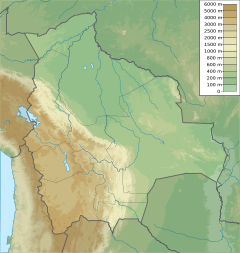Hyloscirtus chlorosteus facts for kids
Quick facts for kids Hyloscirtus chlorosteus |
|
|---|---|
| Conservation status | |
| Scientific classification | |
| Hyloscirtus chlorosteus is only known from Parjacti in the Andes of Bolivia | |
| Synonyms | |
|
Hyla chlorostea Reynolds and Foster, 1992 |
The Parjacti treefrog (scientific name: Hyloscirtus chlorosteus) is a special type of frog that belongs to the Hylidae family, also known as the tree frog family. This frog is found only in Bolivia, which means it is endemic to that country. We only know about this frog from one single specimen, called a holotype, which was found in 1979. It was discovered in a place called Parjacti (also known as Paracti) on the eastern side of the Andes mountains in the Cochabamba Department. The name chlorosteus means "green bones," which is a cool fact about this frog!
Contents
What Does This Frog Look Like?
The only Parjacti treefrog ever found was a young male. It was about 39 to 40 millimeters (about 1.5 inches) long from its snout (nose) to its vent (bottom).
This frog has a noticeable ridge above its eyes and a fold of skin that goes from behind its ear (tympanum) down its side. Its snout looks flat when you look down at it, but it's rounded from the side. The tips of its fingers and toes have large, round pads, which help it climb. Its toes have a lot of webbing between them, while its fingers have a medium amount of webbing.
The frog's back is brown with darker patterns. Its sides and thighs have yellowish marks. Its belly is shiny gold to cream-colored, turning a bit pinkish towards the back. Its chin is shiny gold. The frog's eyes have gold-colored irises. And yes, just like its name suggests, its bones are green!
Where Does This Frog Live?
The only Parjacti treefrog ever found was living in a Yungas forest. This type of forest is found high up in the mountains, about 2,044 meters (6,706 feet) above sea level. The frog was found at night, sitting on a door knob at a station where people check farm products. We believe that the frog's tadpoles, which are baby frogs, grow and develop in water.
Why Is This Frog in Danger?
Even though scientists have looked for more Parjacti treefrogs in the same area, they haven't found any new ones. The place where this frog lives is facing many problems. Its home is being damaged because of farming, cutting down trees (logging), and building new roads and buildings. This means the frog's habitat, or natural living space, is getting smaller and less healthy.
See also

- In Spanish: Hyloscirtus chlorosteus para niños



